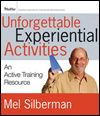|
Experiential Learning

Custom Search
"Learning is not a spectator sport." Teams learn best with action. Teams need to be active, Have fun and work hard. There is an old saying to the effect that the world’s best schoolhouse would be a log with a student sitting on one end and a great teacher on the other. Maybe so – if a “schoolhouse” must be an isolated location.
In the world’s best training or educational design, however, the students would get off the damn log and go experience, firsthand, the things they were learning about. They would actually practice the skills they were trying to master. The teacher would go along as a coach and guide, allowing students to make some mistakes and confront the consequences, while preventing errors that could prove disastrous. From time to time they would return to the log and discuss – or debrief, if you will – the things the students learned from direct experience. Whether sitting on a log or not, any teacher who is genuinely great would tell you the same thing: If you want people to learn to do something—play tennis, fly an airplane, contribute to a work team, run a multinational corporation – don’t just tell them about it, make them do it.
So powerful is the role of direct experience and practice in effective learning that if some form of it is not incorporated into workplace training designs, the organization sponsoring the training is wasting its time and money. It is absurd, bordering on criminal, to give people information about how to perform some vital aspect of their work and end by saying: “Now go forth and practice these skills on the job.”
What skills? Without practice, there is no skill; there is only information. And the first place they’re going to practice is on the job? With real customers, real co-workers, real subordinates? Where mistakes and awkwardness have real consequences for the business?
There is no substitute for experience. That is a bedrock truth. But here is another: There also are no substitutes for guidance during an experience or for reflection afterward. Remember the part where the teacher and students return to the log? That matters. In the absence of informed perspective and valid performance feedback, experience alone is a slow, cruel teacher. And it tends to cement bad habits right along with good ones.
One more truth: An approximation of genuine experience can be as useful as the real thing. Sometimes it’s even better. The best place to learn how to land an airplane at 50 different airports under 50 different wind and weather conditions while suffering 50 different mechanical problems is not in a real airplane. It’s in a flight simulator.
Likewise, games, simulations, and feedback instruments can be wonderfully useful for learning skills pertaining to leadership, teamwork, coaching, conflict resolution, interpersonal communication, and more.
Learning by Design;
Unfortunately, “experiential learning” has become a buzz phrase in the corporate-training community. As tends to occur whenever a good idea turns into a fashionable one, a great deal of nonsense has sprung up around it. You don’t have to look very hard to find “experiential learning” programs that substitute mere activity for relevant experience and practice. Music might play, whistles might blow, people might move about, and some might enjoy themselves. But the activity has little, if anything, to do with generating real insight into the subject at hand or practicing useful skills. “What did we learn from that experience?” An honest answer would be, “Beats me.”
By research and, yes, by experience, we at HRDQ are convinced beyond doubt that experiential learning is the most effective model for training and education. But by that we mean, when it is done right. Doing it right requires several things.
In the first place, any effective learning model must be, in fact, a model, not just a buzzword. In HRDQ’s Experiential Learning Model (see below) experience and practice are two of seven phases leading to the ultimate goal, which is to integrate new skills into work performance. If you aren’t trying to change something about the way people do their jobs, why are you training them? The experience and practice must be relevant, valid, and meaningful. Whatever form the experience takes – game, simulation, or something else – it has to teach the intended lesson. HRDQ’s learning activities are time-tested and proven to do what they say they’ll do.
The teaching process must recognize and incorporate sound educational principles. Certainly, we know that direct experience has an enormous impact on learning. But that isn’t all we know. Educational research and practice demonstrate, for instance, that individuals have different learning styles, and that these styles come into play in significant ways. A great deal also is known about how adult learners differ from children. All of that knowledge should be put to use in an experiential design, just as in any other teaching approach. What are the benefits? What is it? What are some examples? The two papers that follow explain HRDQ’s philosophy of experiential learning in more detail. They cite the research that supports it. And they offer much food for thought about how to create learning experiences that lead to real growth and change, for individuals, teams, and organizations.
Unforgettable Experiential Activities for Training From training expert Mel Silberman, Unforgettable Experiential Activities is a next-step resource based on his well-known Active Training program. As accessible as it is useful, each one of the book's 75 original activities includes helpful training tips and techniques. The collection will help all trainers – both novice and experienced – engage their learners in active, experiential learning. The activities are organized by today's most sought after training topics including: • Change Management • Communication • Conflict • Creativity • Facilitation • Influencing • Leadership • Negotiating • Team Building
Table of Contents: Preface Acknowledgements Introduction Chapter One: Getting Acquainted Chapter Two: Communication Chapter Three: Assertive Behavior Chapter Four: Influencing Others Chapter Five: Conflict and Negotiation Chapter Six: Creativity and Problem Solving Chapter Seven: Diversity Chapter Eight: Facilitating Teams Chapter Nine: Exchanging Feedback Chapter Ten: Leadership Chapter Eleven: Teaching and Coaching Employees Chapter Twelve: Understanding Others Chapter Thirteen: Sales and Customer Service Chapter Fourteen: Building Chapter Fifteen: Train the Trainer
Find this great book at HRDQ:
The Power of Experiential Learning in Leadership Training Presenters: Dr. Rollin Glaser, HRDQ Co-Founder and Gary Turner, HRDQ Senior Consultant Experiential Learning is more than just a buzz word. It’s a tried-and-true method that overcomes one of training’s most difficult obstacles – achieving learning outcomes that generate results. It’s also the key to designing and delivering effective training for the most in-demand business training topic – leadership. But do you know how and why it works – and how to put it into action? • What experiential learning is all about The power of experiential learning“Tell me and I forget. Show me and I remember. Let me do and I understand.” ~ Confucius If you want people to internalize a new skill, you can’t just tell them how—even in a world filled with high-tech gadgets and information at the fingertips. They must do it. And that’s why HRDQ believes in the power of experiential learning. Take interpersonal skills training, for instance. You can listen to someone tell you how to be a better leader, an effective communicator, or a valuable team member. But no matter how much information you absorb about those skills, your first attempts to perform them are likely to be clumsy. Why? Because no practice means no skill. Experiential training raises the odds that training will “transfer” to the job, where it counts. Meaning, people are better able to apply what they have learned in a way that improves their job performance. Practice in the safety of the learning environment gives people the self-confidence to use and refine their skills in the real world. They’ve been there. They’ve done it. And they know they can do it again.Go to HRDQ, to learn more:
|









